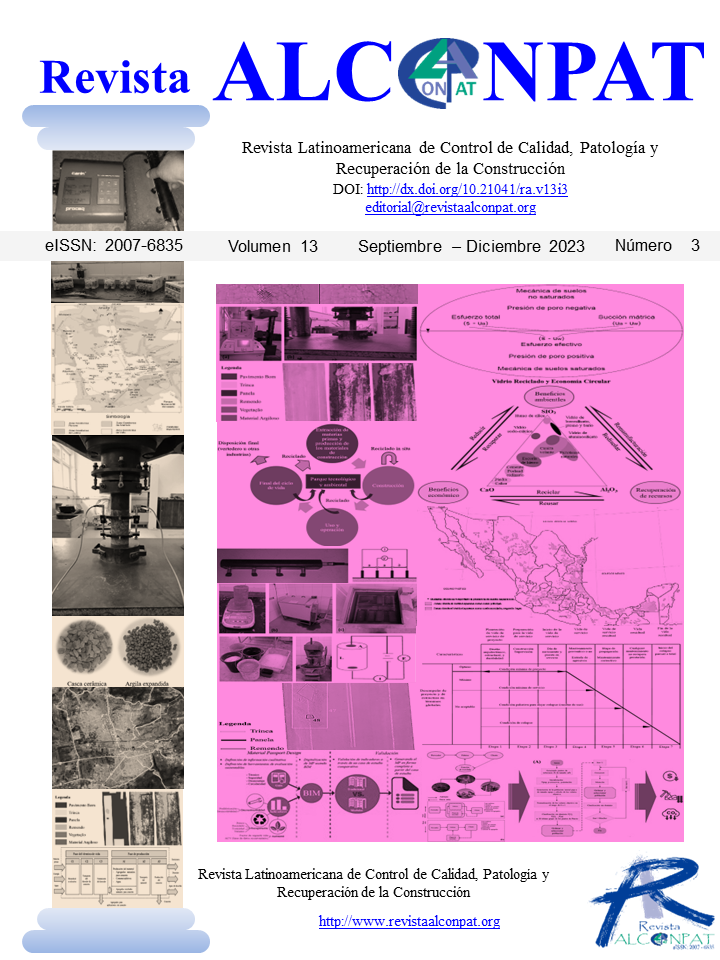Durability of concrete produced with proven internal curing agents subjected to the action of chloride
DOI:
https://doi.org/10.21041/ra.v13i3.665Keywords:
internal curing; porous materials; chlorides action; durability.Abstract
The procedure to promote internal curing is one of the strategies to reduce the shrinkage process of high strength concrete with low water/cement ratio. Various materials have been used as curing agents, such as porous materials, which must meet the minimum requirements defined by ASTM C1761. This research sought to contribute to the development of new ways to inhibit the degradation of reinforced concrete structures through the use of ceramic shell and expanded clay, used as an internal curing agent in concrete subjected to the action of chlorides. Based on the results found, it is possible to verify that the selected aggregates, mainly the ceramic shell, contributed to the improvement of the mechanical properties and durability of the concretes in the evaluated conditions.
Downloads
References
American society for testing and materials. (2022). ASTM C1202: Standard test method for electrical indication of concrete´s ability to resist chloride ion penetration. Philadelphia.
American society for testing and materials. (2015). ASTM C1761: Specification of lightweight aggregate for internal curing of concrete. West Conshohocken.
Associação brasileira de normas técnicas. (2014). NBR 6118: Projeto de estruturas de concreto – Procedimento. Rio de Janeiro.
Associação brasileira de normas técnicas. (2009). NBR 9778: Argamassas e concreto endurecidos – Determinação da absorção de água, índice de vazios e massa específica. Rio de Janeiro.
Associação brasileira de normas técnicas. (2012). NBR 12041: Argamassas de alta resistência mecânica para pisos – Determinação da resistência à compressão simples e tração por compressão diametral. Rio de Janeiro.
Associação brasileira de normas técnicas. (2021). NBR 8522: Concreto endurecido – Determinação dos módulos de elasticidade e d deformação. Rio de Janeiro.
Bolina, Fabricio Longhi. (2019). Patologia das estruturas. In TUTIKIAN, Bernardo Fonseca. HELENE, Paulo. Editora Oficina de Textos.
Byard, B. E. and Chindler, A. K. (2010). Cracking tendency of lightweight concrete. Highway Research Center, Auburn: Auburn University.
Caetano, L. F. (2019). Avaliação do potencial de uso de materiais porosos como agregados para cura interna de concretos com reduzida relação a/c. Tese (Doutorado em engenharia) Programa de Pós-Graduação em Engenharia Civil – Universidade Federal do Rio Grande do Sul, Porto Alegre.
De la Varga, I.; Castro, J.; Bentz, D. P.; Weiss, J. (2012) Application os internal curing for mixtures containing high volumes of fly ash. Cement and Concrete Composites. v. 34, n. 9. https://doi.org/10.1016/j.cemconcomp.2012.06.008
Kim, J. H. et al. (2018). Influence of internal curing on the pore size distribution of high strength concrete. Construction and Buildings Materials. v. 192. https://doi.org/10.1016/j.conbuildmat.2018.10.130
Mehta, P. K; Monteiro, P. J. M. (2014). Concreto: microestrutura, propriedades e materiais. São Paulo: IBRACON, 2014.
Pereira da costa, F. B. (2015). Análise da Durabilidade de Compósitos Cimentícios de Elevada Capacidade de Deformação Reforçados com Fibras. 169 f. Dissertacao (Mestrado em engenharia civil) - Programa de Pos-graduacao em Engenharia Civil, Universidade Federal do Rio Grande do Sul, Porto Alegre.
Silva, T. J. (2011). Mecanismos de Transporte de Massa no Concreto. In: ISAIA, G. C. Concreto: Ciência e Tecnologia. São Paulo: IBRACON
Thomas, M. D. A. (2006). Chloride Diffusion in High-Performance Lightweight Aggregate Concrete. In: Malhotra, V.M. 7th CANMET/ACI International Conference on Durability of Concrete. Farmington Hills: American Concrete Institute, p. 797-812. DOI: https://doi.org/10.1016/j.conbuildmat.2014.01.068
Downloads
Published
How to Cite
Issue
Section
License
_______________________________
License in effect from September 2020
You are free to:
- Share — copy and redistribute the material in any medium or format for any purpose, even commercially.
- Adapt — remix, transform, and build upon the material for any purpose, even commercially.
- The licensor cannot revoke these freedoms as long as you follow the license terms.
Under the following terms:
- Attribution — You must give appropriate credit , provide a link to the license, and indicate if changes were made . You may do so in any reasonable manner, but not in any way that suggests the licensor endorses you or your use.
- No additional restrictions — You may not apply legal terms or technological measures that legally restrict others from doing anything the license permits.
Notices:
You do not have to comply with the license for elements of the material in the public domain or where your use is permitted by an applicable exception or limitation .
No warranties are given. The license may not give you all of the permissions necessary for your intended use. For example, other rights such as publicity, privacy, or moral rights may limit how you use the material.





















.png)














